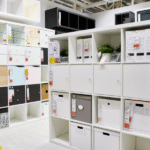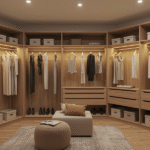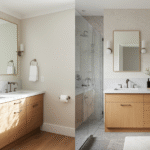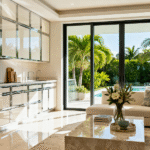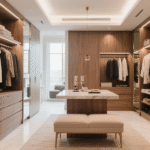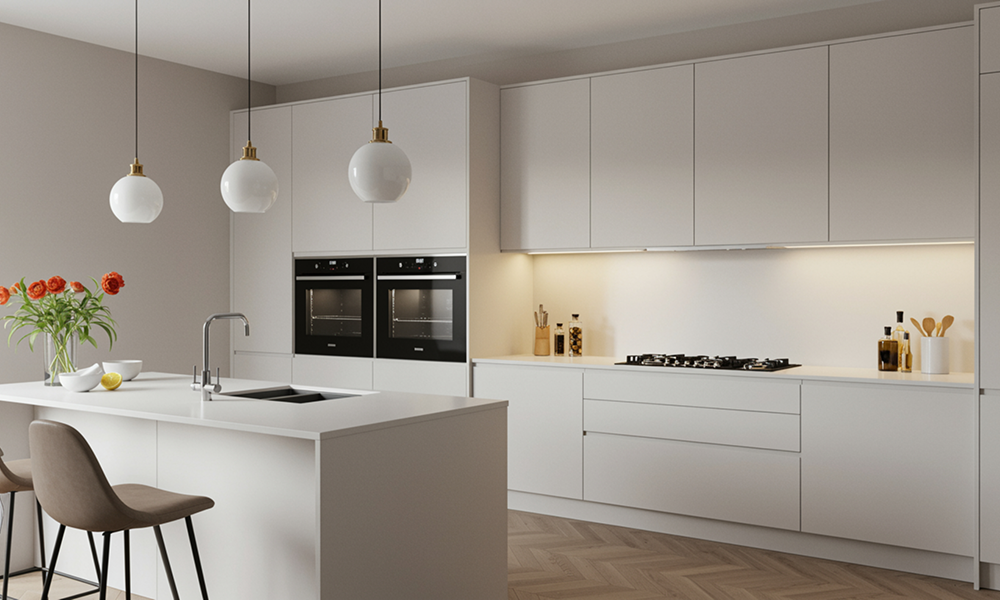
Built-In vs Freestanding Kitchen Cabinets: Which Is Right for You?
Oct 03, 2025
The first step towards a well-planned kitchen is selecting the correct cabinetry. A choice of built-in and freestanding cabinets affects not only storage, but also the organization and design of your area. Homeowners are seeking a competitive functionality that suits their lifestyle and the design of their kitchen.
Both styles offer their own unique benefits, and it is essential to know which one suits you best. Before we settle on custom kitchen cabinets, we will see the differences and advantages of each.
What Are Built-In Kitchen Cabinets
Built-in cabinets in the kitchen are designed to blend seamlessly with the overall kitchen design. They are permanent structures that maximize the use of space and create a smooth, uninterrupted appearance. These cabinets typically extend all the way to the walls, offering a unified design that complements the entire kitchen build.
Contemporary homeowners prefer built-in cabinets in their homes because of their custom fit and modern appearance. The custom-made solutions by reputable cabinet manufacturers are tailored to fit the size and style preferences of every client. This design ensures that all space is well utilized without being cluttered, in a contemporary style.
What Are Freestanding Kitchen Cabinets
Freestanding kitchen cabinets offer flexibility and uniqueness. They can also be transported or relocated according to your requirements or your taste, unlike built-in ones. This will make them suitable for renters or homeowners who have the time to occasionally adjust the kitchen layout.
These cabinets are available in various styles, materials, and sizes, offering a wide range of design options. A significant number of cabinet manufacturers in the kitchen now produce modular freestanding units that incorporate ease and a touch of traditional style, giving kitchens a relaxed yet trendy appearance.
Key Differences Between Built-In And Freestanding Cabinets
The decision to use built-in or freestanding cabinetry requires careful consideration of several factors, including space, cost, and functionality. Each choice has its own benefits and drawbacks. The points below will help you make an informed decision based on your home design and storage needs.
Space Organization And Planning
The cabinets are made to fit inbuilt, so they accommodate the dimensions of your kitchen, allowing you to utilize even the most unusual corners and narrow spaces effectively. They provide a smooth, coherent look and feel that seamlessly matches the wall and countertops, which is why they are the first choice for any homeowner intending to upgrade their kitchen cabinets to improve design and functionality.
Freestanding cabinets, on the other hand, are flexible in terms of layout modifications and mobility. Most cabinet manufacturers have now developed freestanding modular units that maximize the usable floor space but retain flexibility of movement, providing the best practicality and design versatility.
Aesthetic Appeal And Design Cohesion
Built-in cabinets provide a clean and modern look and feel of permanence. They are also incorporated into the kitchen walls and countertops, providing a high-end, architectural finish that complements other home design elements, such as custom closet systems. The outcome is a seamless, integrated space that is spacious and majestic.
Instead, freestanding cabinetry allows for greater creativity in mixing colors, materials, and finishes. Most cabinet manufacturers offer mix-and-match styles, which enable homeowners to create the kitchen that speaks to their personality and creates a balanced aesthetic.
Installation And Customization
Built-in kitchen cabinets require expert assembly and precise measurements, and are typically adjusted to fit the specific design of your kitchen. This guarantees high-quality workmanship and durability, but may add time to the installation process, particularly when comparing European and American Cabinetry design options for your house.
Freestanding cabinets contain less disruption as they are easily installed. Esteemed cabinetmakers have augmented their designs with customizable shelving, adjustable height, and new storage solutions— they provide the same customized experience as built-ins with none of the permanence.
Maintenance And Durability
Built-in cabinets are more resistant because they are fixed with a solid structure. They do not need as much movement, leading to wear and tear. They continue to look new many years later due to regular cleaning and periodic refinishing.
With their portability, freestanding cabinets would be easier to clean under or behind. They can, however, be slightly unstable with time. This problem is addressed by high-profile cabinet producers who can provide better base support and strengthened joints, thereby ensuring the long-lasting performance of the products.
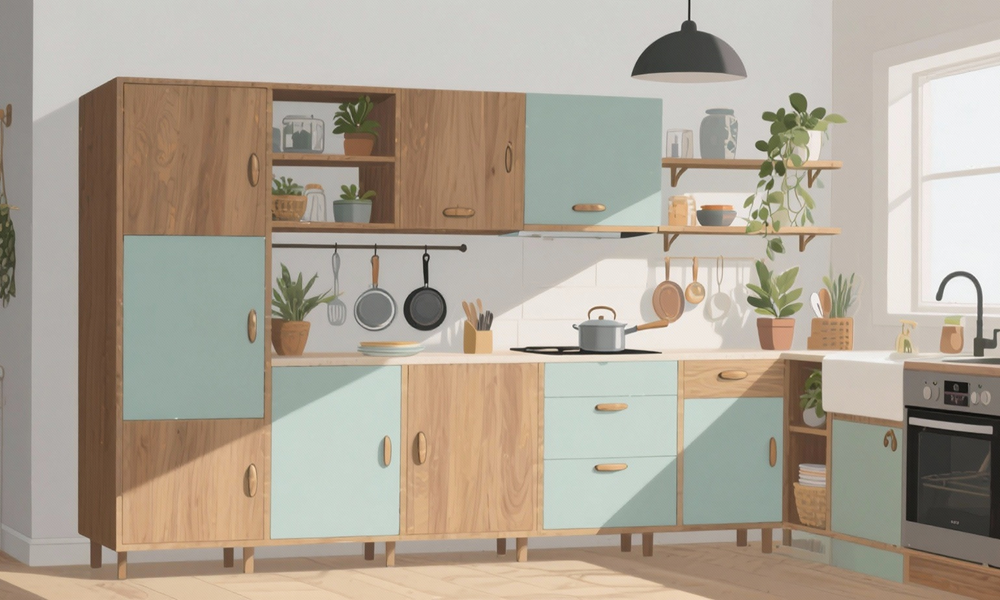
Cost And Investment Value
Built-in cabinetry is more expensive at the outset because it is designed to be custom and installed with professional-grade products. Nevertheless, it boosts the resale value of your house with the addition of long-lasting and high-quality storage systems.
Freestanding cabinets are more cost-effective in the short term and can be easily upgraded or replaced without any issues. Modular units, which are affordable, stylish, and do not compromise quality, are now offered by innovative cabinet makers to meet the needs of small budgets and modern designs.
Flexibility And Portability
Built-in cabinets are also very stable in the long run and have a fixed design that suits homeowners who will be occupying their homes for an extended period. They establish a regular and well-organized space that can be used to cook or entertain regularly.
Freestanding cabinets are also portable and hence suitable for people who rent or change decorations too often. Modern cabinet makers have developed light yet durable furniture that offers both portability and storage quality that can be trusted in the long run, regardless of where you move.
Storage Capacity And Functionality
Built-in Cabinets are usually better in terms of storage, as they are designed to fit your kitchen’s structure. Organization is not a problem, as there are drawers that pull out or compartments built in, along with shelving.
Freestanding cabinets provide an effective storage system that can adjust to variations in needs. Numerous cabinet makers have incorporated intelligent storage capabilities, such as removable trays or adjustable shelves, into a practical and attractive design.
Conclusion
Both built-in and freestanding kitchen cabinets have their own merits, which suit different lifestyles and tastes. Built-in furnishings are classic and offer a smooth finish, and freestanding furnishings offer flexibility and beauty. The decision you make must be based on space, budget and design objectives.
Maple Haus USA specializes in creating high-quality cabinetry tailored to modern homes. Their expertise in custom design and craftsmanship ensures every kitchen achieves the perfect balance of function and style. To learn more or request a consultation, contact us today.
Frequently Asked Questions
Are built-in kitchen cabinets more energy-efficient than freestanding ones?
Yes, by designing built-in kitchen cabinets, energy efficiency can be enhanced by eliminating air gaps above and surrounding appliances, which helps maintain constant kitchen temperatures.
Can freestanding kitchen cabinets be customized to match existing decor?
Indeed, contemporary freestanding cabinets can be tailored to match other kitchen interiors in terms of finishes, handles, and color choices, creating a cohesive look with existing kitchen furnishings.
How long does it take to install built-in kitchen cabinets?
Depending on the complexity of the design, the choice of materials, and the coordination with professional cabinet installers, installation usually takes between one and two weeks.
